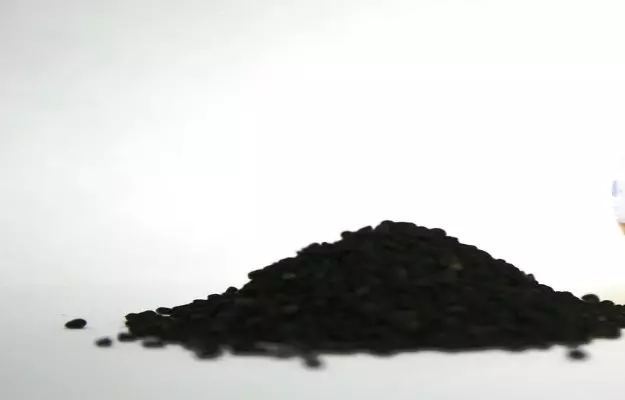Kalonji or nigella seed is known by different names all over the world. In English, it is called samal fennel. Kalonji has multiple names in various Indian languages too. While it is called ell or karun jeeragam in Malayalam, it is known as kalonji in Gujarati, Mogrel in Bengali and kale til in Marathi.
The botanical name for kalonji is Nigella sativa and it comes from an evergreen plant belonging to the Ranunculaceae family. One of the most valued medicinal seeds, kalonji acts a good flavouring agent in dishes as well. It is a very important component of curry masala and garam masala. The bitter note in the aroma of Indian pickles is because of the presence of Nigella seeds in them. It is used as a flavoring agent in many popular Indian dishes like kadhi, samosa, kachori etc.
Kalonji can be used in different forms like kalonji oil, roasted seeds, raw seeds, etc. Although they taste bitter when eaten raw, when added to dishes, kalonji seeds tend to enhance their flavour. Kalonji has a sharp and slightly bitter flavour and a spicy-sweet aroma. It is available in three colours, that is, yellowish-orange, white and black.
Native to Southern Europe, North Africa, and Southwest Asia, Nigella is cultivated in many countries in the world like the Middle East, Mediterranean region, South Europe, India, Pakistan, Syria, Turkey, and Saudi Arabia.
Kalonji seeds and kalonji oil have been widely used for centuries in the Indian traditional medical systems like Unani and Ayurveda and is also recommended in the Tibb-e-Nabwi (Prophetic Medicine). Kalonji is known to be very helpful in reducing cholesterol and it helps in keeping the body fit. Additionally, it acts as a natural remedy for many health problems like reducing high blood pressure, curing heart problems and even skin problems and allergies.
Some basic facts about Kalonji:
- Botanical name: Nigella Sativa
- Family: Ranunculaceae
- Common name: Black cumin, kalonji, black caraway, Nigella
- Sanskrit name: कृष्णजीरा Krishnajira
- Parts used: The fruits of the Nigella sativa plant contain many seeds which are commonly used as a spice.
- Native region and geographical distribution: Though there is inadequate information about the origin of kalonji, traces of seeds have been found in excavated ancient sites in Egypt and Turkey. The crop is cultivated in Europe, South West Asian countries like India and in North Africa.
- Interesting facts: Renowned Muslim scholar Al Bukhari had glorified kalonji as Habbat Al Barakah that means 'blessed one'. According to him, one of the prophets had termed the black seed as a cure for all conditions except death.
- Kalonji nutrition facts
- Kalonji (Nigella seeds) health benefits
- Kalonji (Nigella seeds) side effects
- Takeaway
Kalonji nutrition facts
Kalonji seeds have been used for the treatment of a variety of health conditions related to most of the vital organs of the body including stomach, intestines, heart, kidney, liver & for immune system support. Nearly 70% of all traditional ayurvedic medicines contain Nigella seeds as an important ingredient.
The seeds are a rich source of protein, fat, carbohydrates, and fibre. The seeds also contain different vitamins and minerals like copper, phosphorus, zinc, iron, vitamin A, vitamin C, vitamin K, etc.
According to the USDA Nutrient Database, 100g of Kalonji contains the following nutrient values:
| Nutrient | Value per 100 g |
| Water | 8.06 g |
| Energy | 375 kcal |
| Protein | 17.81 g |
| Fat | 22.27 g |
| Carbohydrate | 44.24 g |
| Fiber | 10.5 g |
| Sugar | 2.25 g |
| Minerals | |
| Calcium | 931 mg |
| Iron | 66.36 mg |
| Magnesium | 366 mg |
| Phosphorus | 499 mg |
| Potassium | 1788 mg |
| Sodium | 168 mg |
| Zinc | 4.80 mg |
| Vitamin | |
| Vitamin A | 64 µg |
| Vitamin B-6 | 0.435 mg |
| Vitamin C | 7.7 mg |
| Vitamin E | 3.33 mg |
| Vitamin K | 5.4 µg |
| Fats/Fatty acids | |
| Saturated | 1.535 g |
| Monounsaturated | 14.040 g |
| Polyunsaturated | 3.279 g |
Kalonji (Nigella seeds) health benefits
- For weight loss: Kalonji seeds help to reduce body weight and waist circumferences by functioning as an antioxidant.
- For the skin: Since kalonji has antioxidant and antimicrobial properties, its oil can be used against skin conditions like acne, blemishes and scars.
- For cough and cold: Kalonji seeds are effective against cough and cold when taken in the form of a decoction with warm water and honey. Smelling some seeds wrapped in a muslin cloth can help to relieve cold and mucus buildup in the nose.
- For pain: Kalonji seeds possess analgesic and anti-inflammatory properties, which allows it to function as a natural painkiller. It helps to relieve pain, swelling and headaches.
- For the liver: The antioxidant properties of kalonji help to reduce injury to the liver and also prevents infections.
- For the heart: The use of kalonji helps in lowering blood cholesterol levels and thus helps to reduce the risk of cardiovascular disorders.
- Against cancer: Due to their antioxidant properties, kalonji seeds are useful in warding off cancerous growth by functioning against tumour initiation and growth. It even helps in reducing metastasis (the spread of cancerous growth to distant sites).
Kalonji for cough and cold
In case of a cold, kalonji seeds can be consumed by making a decoction with warm water and honey. Taking this decoction twice a day is said to help in killing the bacteria responsible for cough and cold.
Kalonji is a bronchodilator and it possesses antimicrobial, anti-allergic and analgesic (pain relieving) properties as well. It has been reported to be resistant to harmful bacteria and viruses that attack the body.
Kalonji seeds can be roasted and tied in a muslin bag and smelt repeatedly to relieve cold and catarrh of the nose (buildup of mucus in the nose).
kalonji as an antioxidant
One of the most important components in kalonji is thymoquinone, which has been found to possess some antioxidant properties. Animal studies demonstrate that the antioxidant components of kalonji make it very effective against tissue damage caused by ischemia-reperfusion (return of blood in a tissue after a prolonged absence of oxygen.
Kalonji benefits for brain
Recent studies have highlighted the role of flavonoids in improving one’s neurological health. Kalonji is a rich source of flavonoids. It is said to be helpful in boosting one's memorizing ability. It is especially helpful for elderly people as memory power tends to weaken with age. It also improves concentration and acts as a cure for many brain-related problems. Several animal and human-based studies suggest that regular consumption of Nigella seeds can increase the retention power of the brain.
Kalonji reduces pain
Traditionally, kalonji is known to be a natural painkiller. It can relieve pain quickly without showing any side-effects. Extensive research has been conducted on Kalonji which shows that kalonji has potent analgesic and anti-inflammatory properties which help relieve pain and swelling in the body.
To get rid of a headache, kalonji seed oil can be applied on the forehead. Kalonji oil can also be used to cure joint pains caused by arthritis.
Kalonji for weight loss
Studies suggest that ingestion of kalonji seeds can lead to a significant decrease in body weight, body mass index, as well as waist and hip circumference. Additionally, kalonji contains an antioxidant enzyme, nigellone, which shows anti-obesity properties.
(Read more: Obesity treatment)
If you are tired of dieting and exercising and are not able to lose weight, then use myUpchar Ayurveda Medarodh Fat Burner Capsule, it has no side effects, order it today and avail the benefits.
Kalonji benefits for liver
Reactive oxygen species (ROS) and oxidative stress are known to be the major causes of liver injury. Thymoquinone, the main component present in kalonji seed essential oil, protects the liver from injury.
Kalonji also protects the liver from common microbial infections. Consuming kalonji with a spoon of honey helps strengthen vital organs and the bones.
Kalonji benefits for skin
Traditionally, kalonji is considered very useful for maintaining clear and glowing skin. Kalonji essential oil contains many useful chemical constituents such as thymoquinone, thymol, nigellicine, carvacrol, and alpha-hederin. These compounds impart antioxidant, antimicrobial, and anti-inflammatory properties to Nigella seeds. Nigella seeds are thus beneficial against several skin problems like acne, scars, blemishes, pimples, etc. Adding kalonji oil to face packs or mixing it with lime juice makes the face feel fresh and relaxed.
Kalonji for cancer
Kalonji is considered to be a “miracle” herb due to its effective therapeutic potential to alleviate signs and symptoms of many diseases including cancer. Studies have shown protective effects of Nigella seeds against tumour initiation and progression. It has also been found to have potent anti-metastatic (stops spread of cancer cells), anti-mutagenic (reduces cancer risk) and antiproliferative (inhibit cancer growth) properties that help to fight cancer.
Kalonji benefits for heart
A heart attack occurs when blood flow to a section of the heart muscle gets blocked. The main cause of this is the increased triglyceride (a type of fat) levels in the body. These fatty particles travel through the blood and can stick to the arterial walls causing obstructions and resulting in various cardiovascular problems. Kalonji seeds are said to be very good for the heart as it helps in controlling cholesterol levels in the body. Thus protecting it from various kinds of problems like heart attacks and blocked arteries.
To get best results, kalonji oil can be had with milk every day.
(Read more: Atherosclerosis treatment)
Other benefits of Nigella seeds
Kalonji aids in improving overall health by regulating the functioning of the heart, liver, and lungs. It is also useful in treating asthma. Kalonji oil is effective against hay fever and other kinds of allergies.
Honey and kalonji form a very good combination in treating several diseases like – gastric Helicobacter pylori infection, cough and cold, constipation, absent-mindedness and lung problems. It can also be mixed with goat’s milk to improve heart functioning.
Kalonji (Nigella seeds) side effects
Kalonji is an excellent flavouring agent in dishes, and it is safe for most people. When taken in small quantities, kalonji doesn’t pose any side effects. But, in certain cases, it does have some side effects.
- When taken in large amounts, it can lead to low blood pressure and blood sugar levels, which pose a risk to lives.
- Research says that intake of kalonji can stimulate uterine contractions. Ingesting large doses cause abortion. When eaten regularly or consumed in excess, it may affect the health of the foetus. So, pregnant women are suggested to avoid kalonji.
- It is suggested that one should not take kalonji if they have undergone any surgeries or are planning to undergo any. As it can pose a risk of bleeding and might hinder the healing process.
- If you are suffering from gastritis or have a sensitive stomach, it is best to stay away from Nigella seeds as it may increase the burning sensation in the stomach.
- Nigella seeds have a warming effect on the body. People with Pitta body type, who cannot tolerate heat and spiciness may find it difficult to use this spice.
Takeaway
Kalonji seeds have many beneficial properties. Recent discoveries reveal that these seeds are superior to almost every other natural remedy for reducing the risk of heart problems. It is also an excellent antioxidant and analgesic.
Kalonji seeds have been studied for the treatment of various health ailments all over the world.
Therefore it can be safely said that kalonji seeds are a natural blessing to mankind.
Medicines / Products that contain Kalonji
- Planet Ayurveda Yograj Guggul (120) - ₹550
- Dr Chopra Sandda Double Power Oil for Men - ₹169
- REPL Saandhha Oil 15ml - ₹213
- Enorma Immunity Capsule (30) - ₹1730
- Cipzer Veerya Vita Powder 100 gm - ₹449
- Planet Ayurveda Hakam Churna - ₹380
- Cipzer Livolife Ds Syrup 200 ml - ₹449
- Baidyanath Nagpur Meri Sakhi 450ml - ₹420
- Baidyanath Nagpur Meri Sakhi 200ml - ₹216
- Cipzer Heart Calm Syrup 200 ml - ₹449
- Cipzer Blood Purifier Syrup 200ML - ₹449
- Zeroblend Kalonji/Blackseed Oil - ₹625
- Hawaiian Black Cumin Seed Oil Capsule-Get 1 Same Drops Free - ₹469
- Aayuheal Man Night Tablet - ₹1249
- Vedobi Diaba Free Lotion 30 ML - ₹499
- Hashmi Big B Xl Capsule - ₹675
- Hashmi Hard Rock Capsule - ₹1900
- Sitaram Ayurveda Siva Gulika Tablet (50) - ₹1300
- Chetan Shilajit Prash - ₹630
- Aayuheal Man Night Oil - ₹449
- Devson Pharma Elora Oil 30ml - ₹579
- REPL Orthovit Oil - ₹110
- Amar Hair Oil - ₹180
- Anju Kalonji Oil - ₹180
- Vedobi Cholentrol Lotion 30ml - ₹399
- Kanan Naturale Black Seed Oil - ₹378
- Biomedison O2H Onion Oil for Hair - ₹334
- Enorma Immunity Capsule (60) - ₹3410
- Sadhana Blackseed/kalonji oil 100 ml - ₹288
- Sadhana Blackseed/kalonji oil 50 ml - ₹181
- Vedobi Anti Aging Face Oil For Women, Serum Anti Wrinkle - ₹399
- Cipzer Diabofit Capsule (30) - ₹449
- Cipzer Kalonji Softgel Capsule (60) - ₹539
- Cipzer Heart Calm Capsule (60) - ₹899
- Kerala Ayurveda Ashta Choornam - ₹90
- Cipzer Livolife Ds Capsule (60) - ₹899
- Cipzer Majun -E-Kundur 125 gm - ₹449
- Zaarah Kalonji Seeds 200gm - ₹306
- Cipzer Dr Gyne Syrup 200 ml - ₹449
- Shri Chyawan Ayurveda Thyroid Juice 500ML - ₹599
- Devson Pharma Lee-Cap Capsule (6) - ₹599
- Devson Pharma Yamkesho Oil 100ml - ₹547
- Tantraxx Monovit Red Onion Shampoo For Silker And Stronger Hair 100ml - ₹399
- Riddhish Herbals Kesh Nirogi Jadi Butti (Pack of 3) 100gm - ₹330
- 1 Month Haircare Glamyo HerbGro Hair Shampoo Glamyo Hair Conditioner Glamyo Hair Serum Glamyo Hair Oil - ₹1099
- Glamyo HerbGro Hair Oil 200ml - ₹299
- Glamyo HerbGro Hair Shampoo 200ml - ₹299
- Cipzer Hair & Handsome Oil 100 ml - ₹449
- Zenius Hair Oil for hair growth hair dandruff removal oil 200ml - ₹549
- Cipzer Kalonji Oil 50 ml - ₹449
References
- United States Department of Agriculture Agricultural Research Service. Basic Report: 02014, Spices, cumin seed. National Nutrient Database for Standard Reference Legacy Release [Internet]
- Fatemeh Forouzanfar, Bibi Sedigheh Fazly Bazzaz, Hossein Hosseinzadeh. Black cumin (Nigella sativa) and its constituent (thymoquinone): a review on antimicrobial effects. Iran J Basic Med Sci. 2014 Dec; 17(12): 929–938. PMID: 25859296
- Mohamad Khairul Azali Sahak et al. The Role of Nigella sativa and Its Active Constituents in Learning and Memory. Evid Based Complement Alternat Med. 2016; 2016: 6075679. PMID: 27022403
- Aftab Ahmad et al. A review on therapeutic potential of Nigella sativa: A miracle herb. Asian Pac J Trop Biomed. 2013 May; 3(5): 337–352. PMID: 23646296
- Namazi N, Larijani B, Ayati MH, Abdollahi M. The effects of Nigella sativa L. on obesity: A systematic review and meta-analysis. J Ethnopharmacol. 2018 Jun 12;219:173-181. PMID: 29559374
- Hamid Mollazadeh, Hossein Hosseinzadeh. The protective effect of Nigella sativa against liver injury: a review. Iran J Basic Med Sci. 2014 Dec; 17(12): 958–966. PMID: 25859299
- Ahmad M. Eid et al. A Review on the Cosmeceutical and External Applications of Nigella sativa. J Trop Med. 2017; 2017: 7092514. PMID: 29358959
- Amin F. Majdalawieh, Muneera W. Fayyad. Recent advances on the anti-cancer properties of Nigella sativa, a widely used food additive. J Ayurveda Integr Med. 2016 Jul-Sep; 7(3): 173–180. PMID: 27649635
- Fataneh Hashem-Dabaghian et al. Combination of Nigella sativa and Honey in Eradication of Gastric Helicobacter pylori Infection. Iran Red Crescent Med J. 2016 Nov; 18(11): e23771. PMID: 28191328


































